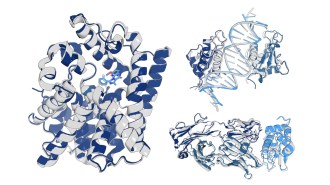- More than 2 years ago
By developing a novel way to make molecules assemble themselves, researchers may

have opened a new route to microscopic devices, including nanoscale electronics.
Like Tinkertoys or Lincoln Logs, the molecules connect to each other only at
certain points. As a result, the molecules build into predictable shapes.
“We believe that this is a breakthrough for advancing
molecular nanotechnology,” says Takashi Yokoyama of the National Institute for
Materials Science in Nagoya, Japan. Yokoyama and his coworkers report the work in
the Oct. 11 Nature.
To make their molecular structures, the researchers tailored molecules, called
porphyrins, by adding a chemical appendage to one or more of four possible
locations. The researchers then made the molecules adsorb onto a flat, gold
surface.
The appendages, called cyanophenyl groups, made predictable linkages with each
other. When each porphyrin hosted one such appendage,
the molecules organized into trios, for example. When cyanophenyl groups were on
opposite ends of each porphyrin, the molecules lined up into wires.
The researchers now plan to measure the electronic and optical properties of the
structures, says Yokoyama. He suspects that the new technique could also work with
different molecules and on surfaces other than gold, such as silicon.






